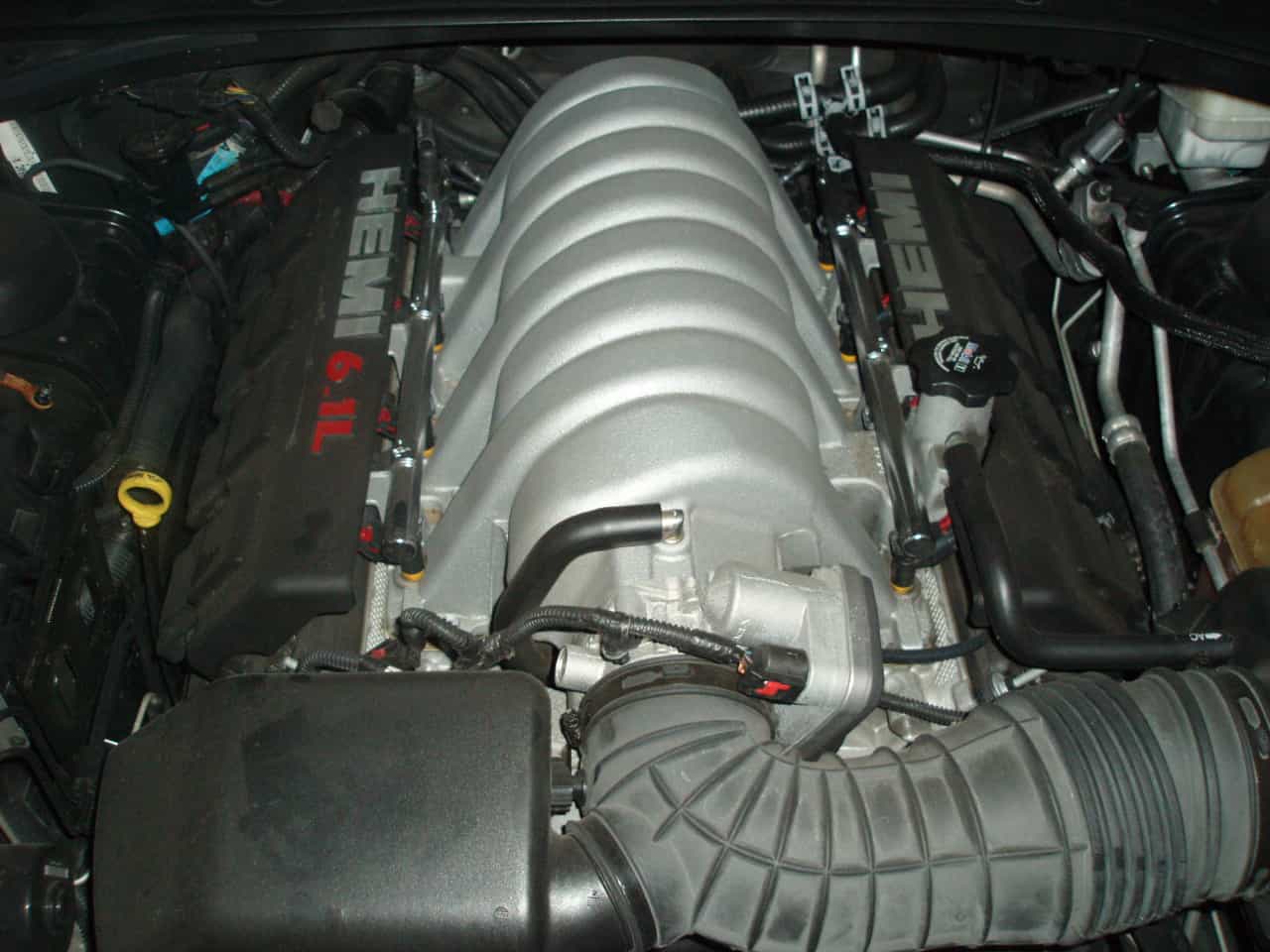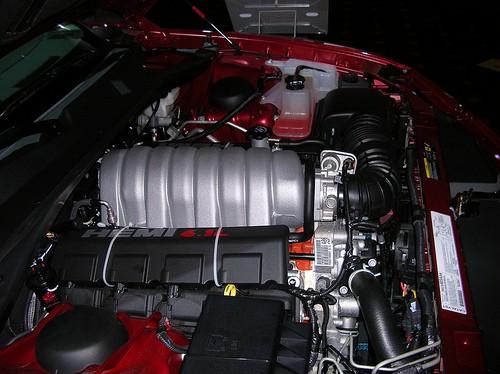The 6.1 HEMI engine is a sturdy, heavy-duty motor of excellent craftsmanship. You can get over 250,000 miles from the 6.1 HEMI if you perform routine maintenance and the necessary services to keep it up and running.
What’s special about this model is that it gives you 425 horsepower along with 420 pound-foot torque. The high-performing 6.1 L HEMI is a solid choice, and if you own a vehicle with one or you’re searching for an older model with a HEMI, you’ll appreciate the 6.1 HEMI V8.
Despite how solid of an option it is, there are some common problems that this engine possesses. We’ll cover those issues as well as discuss the overall reliability.
6.1 HEMI® V8 – Engine Specifications
Here are the 6.1 HEMI specs:
| Production Period: | 2005 – 2010 |
| Cylinder Block Construction: | Cast-iron |
| Cylinder Head Construction: | Aluminum |
| Configuration: | V8 |
| Stroke: | 90.9 mm |
| Bore: | 103 mm |
| Valvetrain: | Two valves per cylinder, OHV |
| Compression Ratio: | 10.3 |
| Displacement: | 6.1L (6059 cc) |
| 6.1 HEMI Weight: | 560 pounds |
| 6.1 HEMI Horsepower: | Maximum of 425 HP at 6,200 RPM |
| 6.1 HEMI Torque: | Maximum of 420 lb-ft at 4,800 RPM |
Although the manufacturers modeled the 6.1 HEMI engine after the 5.7 HEMI, you’ll see notable differences in the 6.1 HEMI engine specs. The engine block has a new design with revised coolant channels equipped with oil jets, reinforced heads, better durability, and a deep-skirt design.
6.1 HEMI® V8 – Short History
The 6.1 HEMI engine is a piston drive with a wet-sump system. This naturally aspirated, water-cooled gasoline motor arrived in 2005 in the 300C Chrysler SRT-8. The infrastructure is similar to the 5.7 HEMI engine, but the 6.1 SRT8 also incorporates racing technologies that allow the vehicle to reach high-top speeds.
The 6.1 L HEMI engines don’t have a multi-displacement system or variable-length technology. The MDS system boosts fuel economy, but it’s at the cost of your full torque and engine power. Even without these mechanizations, the engine outperforms several others in this class.
The Dodge 6.1 HEMI and the Chrysler 6.1 HEMI V8 engines are on the following vehicles:
- 2005-2010 Chrysler 300C SRT-8
- 2006-2010 Jeep Grand Cherokee SRT-8
- 2006-2008 Dodge Magnum SRT-8
- 2006-2010 Dodge Charger SRT-8
- 2008-2010 Dodge Challenger SRT-8
6.1 HEMI® V8 – Overview
What many engine enthusiasts love about the Chrysler HEMI engine is that the robust construction makes it possible to add plenty of modifications in the future.
It’s a lighter engine than the 5.7 L because it has more lightweight pistons, stronger connecting rods, a cast-aluminum alloy cylinder head, and turbocharger capabilities. It’s a sophisticated machine that performs as well as it looks.
6.1 HEMI® V8 – Advantages and Disadvantages
Here are the pros and cons of a 6.1 HEMI engine:
Pros:
- Easy to modify
- Life expectancy over 250K miles
- Responsive throttle
- 425 horsepower
- 420 pound-foot torque
- Lighter engine
Cons:
- No MDS system to improve fuel economy
- It may have misfiring issues
6.1 HEMI® V8 – Engine Problems and Reliability
A few of the most common problems on the Dodge-Chrysler 6.1 HEMI include:
- Misfiring
- Oil consumption
- Lifters and rollers
While these are the most commonly reported 6.1 HEMI problems, it doesn’t necessarily mean that these issues regularly occur. It’s more so that when there are problems with the engine, these are the most likely sources.
Chrysler 6.1 HEMI Lifter Roller Problems
For HEMI engines in general, particularly the 6.1 L model, seized lifter rollers are a significant problem with this machine. It doesn’t seem that this problem affects most vehicles with this engine, but it can wreak havoc from time to time. It appears that the root of the issue is low lubrication and poor design.
What usually happens is that the lifter rollers will seize, which causes the lifter to affect the cam lobes. You’ll start to notice a ticking noise because of the two metal parts touching one another.
When the lifters start touching the cam lobes, and the metal continues rubbing against each other, it can cause metal shavings to escape into the motor oil.
While your oil filter should help catch most of it, you should get it repaired promptly to avoid further problems. Letting it sit for too long may cause additional damage if those shavings get into the oil pump.
Signs of Faulty Lifter Rollers
- Ticking
- CEL
- Misfires
It can be challenging for mechanics to determine that your lifter rollers or the lifters are compromised. The most common way to tell is the ticking sound, even if nothing else seems off with the vehicle.
As time progresses, you might see your check engine light come on if the engine starts misfiring. An engine tick doesn’t necessarily point to faulty lifters and lifter rollers, so be on the lookout if the problem worsens and these additional signs occur. It’s helpful to know that lifter roller failure usually happens around 70K-120K miles.
6.1 HEMI Misfiring Problems
Though misfiring alone doesn’t usually happen with any vehicles, it is a sign of an underlying issue. The 6.1 HEMI engine seems to experience misfires for various reasons. The 6.1 L has 16 spark plugs, which leaves a wide margin for error regarding wear and tear.
Since this motor is a high-performance piece, the spark plugs are only good for close to 40K miles, topping out at around 70K miles. Most of the damage will occur depending on how hard you drive your vehicle. Don’t push it too hard if you’d like to preserve your engine for as long as possible.
Tend to the ignition coils as well, even though they’re generally twice as durable as the spark plugs. They are, however, another reason the engine may misfire. Essentially, stay on top of regular car maintenance to avoid an issue with your car that might be preventable.
Signs of 6.1 V8 Misfiring
Here are signs that your 6.1 HEMI engine is misfiring:
- Rough idle
- Poor performance
- Fault codes
- Stuttering/hesitation
When your vehicle misfires, it should cause the Dodge/Chrysler HEMI engine sends a fault code. Additionally, engine hesitation and a rough idle may indicate signs of misfiring. Power loss may occur; however, if it stems from one of the 16 spark plugs, chances are you won’t notice it.
A wide array of other issues could cause the 6.1 HEMI engine to misfire; with that said, spark plugs are most common. With standard maintenance alone, you should be able to avoid this problem. However, remember that two spark plugs per cylinder services increase the possibility of failures and increase repair costs.
6.1L Oil Consumption Problems
Although this is not as common as the other problems mentioned above, excessive oil consumption can be the motive for the engine completely failing. As a result, it is important to check oil levels on the 6.1L V8 every week.
At any rate, excessive oil consumption doesn’t seem to have any adverse effects on 6.1 HEMI’s longevity or reliability. Of course, all engines will consume oil because of natural oil blow-by. It’s also not uncommon for some cars to consume more than others.
However, if oil consumption is happening at an alarming rate, such as one or more quarts per 1,000 miles, you may have a more severe problem that you need to check out.
That said, it’s good practice to check oil levels regularly. Losing oil too quickly can cause low oil pressure, which causes extra stress on your bearings. Bearings or rods rarely are the reasons for 6.1 HEMI engines to suffer from failures. Therefore, poor oil quality or low oil will be the likely culprit in such cases.
Ways to “Fix” the Oil Consumption Problems
Try the following methods to decrease oil consumption in the 6.1 HEMI engine:
- Get your oil changed every 6K miles
- Use premium oils
- Install an OCC (oil catch can)
- Avoid incessant idling
These are the basics that should keep your car in tip-top shape. Of course, high-performance engines are thirsty for the good stuff, so you may have to splurge a bit with the oil.
The oil catch can is a great tip because many car owners might not realize that it also helps prevent carbon buildup in addition to catching the oil and reducing consumption.
6.1L HEMI V8 Engine – Reliability
So, after reviewing the engine’s construction, the pros, cons, and common problems, we’d say the 6.1L V8 engine is reliable. Despite it no longer being in production for the past 12 years, the 6.1 HEMI engine is still one of the most sought after engines on the used car market.
It may not be the best engine out there, but it’s also still one of the most reliable. There aren’t as many features as some of the other more modern HEMI engines, but the simplicity helps.
Also, ensure that you’re not racing the car and using it to travel rocky terrain, as this can place too much stress on the engine, especially if done on a daily basis. While the engine is able to stand up to high speeds, you don’t want to drive it into the ground.
The best way to ensure that you get the most out of your 6.1 L HEMI engine is to take care of it according to the manual and your trusted mechanic. Use top notch oils, brake fluid, and check your car every few weeks to see if everything is in working order. Get all repairs in a timely fashion, and the reliability and performance.
6.1 HEMI V8 Upgrades
When tuning a 6.1 L HEMI V8 engine entails the replacement of the ignition coils and the spark plugs. Although it may feel more like a typical maintenance routine, keeping the engine running optimally is essential.
The engine possesses a nice amount of torque. That combined with the fact that it is a massive displacement engine, you are sure to have a satisfying driving experience.
You can choose to put a turbocharger in your engine, but ensure you buy a turbo header build kit. Other kits also include a welded V-band flange on a 90-degree mandrel bend while all stage one upgrades.
Additional upgrades:
- There’s a 35 percent power increase with the upgraded lighter weight 6.1 Hemi engine. Though it’s lighter, it doesn’t take away from the torque, but allows for smoother riding at high speeds.
- The 6.1 and its con rods are thicker and more robust with stronger bolts.
- Hemi 6.1 caps have the same problems as the 5.7, even with the reinforced bulkheads and 3.5mm-thicker cylinder walls. The 6.1 is good for up to 1,800 crank hp with the stock stroke; up to 1,400 hp with 4-inch (or more) strokes.
6.1 HEMI® V8 – FAQ
Here are the responses to the most commonly asked questions regarding a 6.1 Hemi V8:
1. What is the cubic inch size of the 6.1L?
According to the Dodge website, if you look at specs and upgrades in the technical tab. The SRT 6.1 HEMI in cubic inches is 370.
2. Does the 6.1 Hemi have forged internals?
The 6.1-liter Hemi V8 engine is stronger, with redesigned components. The reinforced engine block and forged steel crankshaft along with high-quality connecting rods ensure that this engine won’t quit on you anytime soon.
3. How much horsepower does a supercharger add to a 6.1 HEMI?
Numerous car owners have stated that your best bet is to get a supercharger kit for the value. The 6.1 HEMI engine will increase the horsepower as much as 160 or more with this upgrade.

